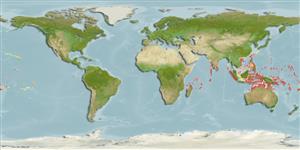Common names from other countries
Environment: milieu / climate zone / depth range / distribution range
Ecología
marino asociado a arrecife; rango de profundidad 8 - 30 m (Ref. 90102). Tropical; 30°N - 18°S
Indo-Pacific: East Africa to the Society Islands, north to Ryukyu Islands and south to Australia.
Tamaño / Peso / Age
Maturity: Lm ? range ? - ? cm
Max length : 13.2 cm TL macho / no sexado; (Ref. 90102)
Espinas dorsales (total) : 7; Radios blandos dorsales (total) : 12 - 13; Espinas anales: 3; Radios blandos anales: 9. Body and fins dull yellowish brown; prominent dark ocellus on opercle; dark brown spot on each side of chin (Ref. 4326).
Found on coral heads of lagoon and seaward reefs from 3 to at least 15 m (Ref. 1602). Solitary or in pairs, seldom seen (Ref 90102).
Life cycle and mating behavior
Maturities | Reproducción | Spawnings | Egg(s) | Fecundities | Larva
Paxton, J.R., D.F. Hoese, G.R. Allen and J.E. Hanley, 1989. Pisces. Petromyzontidae to Carangidae. Zoological Catalogue of Australia, Vol. 7. Australian Government Publishing Service, Canberra, 665 p. (Ref. 7300)
IUCN Red List Status (Ref. 130435)
CITES (Ref. 128078)
Not Evaluated
Threat to humans
Harmless
Human uses
Herramientas
Special reports
Download XML
Fuentes de Internet
Estimates based on models
Preferred temperature (Ref.
115969): 26.4 - 28.9, mean 27.9 (based on 198 cells).
Phylogenetic diversity index (Ref.
82804): PD
50 = 1.0000 [Uniqueness, from 0.5 = low to 2.0 = high].
Bayesian length-weight: a=0.00427 (0.00166 - 0.01096), b=3.17 (2.94 - 3.40), in cm Total Length, based on LWR estimates for this (Sub)family-body shape (Ref.
93245).
Nivel trófico (Ref.
69278): 3.7 ±0.6 se; based on size and trophs of closest relatives
Fishing Vulnerability (Ref.
59153): Low vulnerability (10 of 100).
